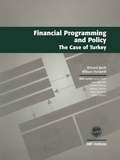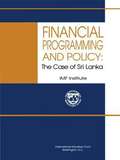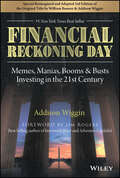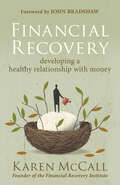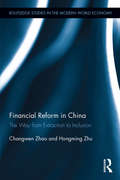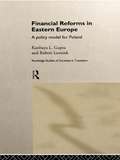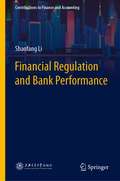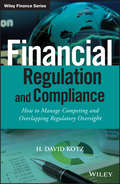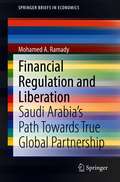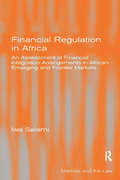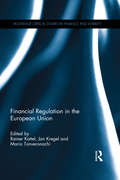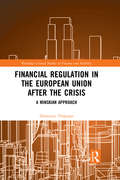- Table View
- List View
Financial Prep 101: Simple Tips for the Next Generation
by Janis R DickeyStep into the future of finance with Financial Prep 101: Simple Tips for the Next Generation.This practical workbook serves as your guide to financial freedom, demystifying the often-intimidating world of finance with straightforward explanations. Designed for both teens and adults, this easy-to-read resource brings clarity to essential financial terms and concepts that everyone should know.Navigate everyday financial choices with ease as you learn about budgeting, saving, investment strategies, financing and borrowing options, retirement planning, and safeguarding your wealth.Don&’t miss out on your pathway to financial literacy and success – your blueprint for a secure financial future starts here!
Financial Products: An Introduction Using Mathematics and Excel
by Bill DaltonFinancial Products, first published in 2008, provides a step-by-step guide to some of the most important ideas in financial mathematics. It describes and explains interest rates, discounting, arbitrage, risk neutral probabilities, forward contracts, futures, bonds, FRA and swaps. It shows how to construct both elementary and complex (Libor) zero curves. Options are described, illustrated and then priced using the Black Scholes formula and binomial trees. Finally, there is a chapter describing default probabilities, credit ratings and credit derivatives (CDS, TRS, CSO and CDO). An important feature of the book is that it explains this range of concepts and techniques in a way that can be understood by those with only a basic understanding of algebra. Many of the calculations are illustrated using Excel spreadsheets, as are some of the more complex algebraic processes. This accessible approach makes it an ideal introduction to financial products for undergraduates and those studying for professional financial qualifications.
Financial Programming and Policy
by William Hemphill Richard BarthA series of workshops introducing readers to the process of formulating a macroeconomic adjustment programme, designed to move a country toward internal and external balance. Turkey is a middle income developing country which has made great progress towards industrialisation, but not without setbacks and stabilisation problems. It therefore presents a wide range of relevant issues for study.
Financial Programming and Policy: The Case of Sri Lanka
by John KarlikA report from the International Monetary Fund.
Financial Ratios for Executives
by Rist Michael Pizzica Albert J.Financial Ratios for Executives is written specifically with today's global executive in mind. It makes financial ratios easy to understand and use effectively. This short book will prove invaluable to both financial and non-financial executives looking for easy, intuitive methods to assess corporate health and assist in strategic decision making. Financial Ratios for Executives contains over 100 financial ratios and other useful calculations. It includes ratios that are commonly used, such as return on investment (ROI), return on assets (ROA), return on equity (ROE), economic value added (EVA), and debt-to-equity ratio, just to name a few. It also includes many less-well known--yet powerful--ratios that can provide unparalleled insight into operations, financial management, sales and marketing efforts, and overall performance, among other areas. Using realistic financial and operational data from two fictional companies, the explanation of each ratio includes: Type of ratio Formula for calculating the ratioDescription of the ratioExample based on ABC Company or XYZ CompanyAdditional comments or insightsIn addition to the section on financial ratios, financial experts Michael Rist and Albert Pizzica have included a section on capital budgeting, an understanding of which is essential for both the financial and non-financial executives before they take part in an annual budget meeting or any other business meeting where capital allocation is discussed. It includes the most important tools of finance, such as net present value (NPV), internal rate of return (IRR), payback method, and total cost of ownership. Who gets ahead in the business world? Those who understand the numbers. It's as simple as that. Financial Ratios for Executives is for those who want to understand how to use financial data to support their initiatives, solve persistent problems, uncover opportunities, bolster company health, and shine in corporate meetings.
Financial Reckoning Day: Memes, Manias, Booms & Busts ... Investing In the 21st Century
by Addison Wiggin William BonnerAn engaging and practical romp through contemporary financial and economic history—and what it means for your financial future Economic booms and busts are happening with more frequency. Since the turn of the new millennium, fortunes have been made and lost at a blistering pace. Each boom is like the tension building up before an earthquake. Seismologists can detect the build-up, but they can't necessarily explain why—or when—the next quake will hit. Economic busts can be equally devastating…and followed by numerous aftershocks. In this entertaining romp through recent economic and financial history, best-selling author, Addison Wiggin, traces the primary trends that have led up to rapid economic growth and innovation while keeping an eye on the inevitable downturn. The author practices "literary economics," telling stories about the characters behind the scenes and their motives, making this wide-ranging book easy-to-read. The current edition has been revised, adapted, and re-imagined, enlightening readers about what's happening behind today's top headlines: The rise of new financial innovations over the past decade, including cryptocurrencies, mobile trading platforms, and the democratization of financial markets How the policies of the Federal Reserve following the Panic of '08 led an entire generation to become unwitting speculators in stocks, bonds, real estate, and rare commodities What impact new political trends—environmental, social, governance (ESG) and diversity equity and inclusion (DEI)—have had on managing your own money Ultimately, the book helps place current events in the context of identifiable historical trends. The book proposes that when you understand what the primary trends are and follow them to their logical conclusion, it makes planning for your financial future much easier. What will be the role of the US economy in the future as policy makers try to grapple with new competition, economic and political, from Brazil, Russia, India, China - the so-called BRICs? The author follows the facts, the trends, and the stories that make up history and parlays them into forecasts for what he sees coming next. Ultimately, you'll get a review of previous trades and a new Trade of the Decade.
Financial Recovery: Developing a Healthy Relationship with Money
by Karen McCallAfter healing her own unhealthy relationship with money, and transforming her financial disaster into prosperity and security, Karen McCall created a recovery program she has now used for more than twenty years to help individuals, couples, and businesses large and small. In the midst of her money troubles, she saw a need for something other than financial planners, accountants, and credit counselors. These experts could tell her what she should be doing differently, but she needed someone to help her understand the underlying causes of chronic, self-defeating overspending and credit card debt, underearning, and low or no savings. To save herself, she created practical, holistic tools that address these sources of pain and shame. McCall’s program supports people as they uncover their deep-seated attitudes about money; provides simple, step-by-step tools for healing areas of physical, emotional, and spiritual deprivation; and teaches skills and strategies for experiencing lasting personal and financial fulfillment even in the midst of economic challenges and reversals.
Financial Reform in China (Routledge Studies in the Growth Economies of Asia #Vol. 2)
by On Kit TamChina's spectacular economic growth has made it the focus of international attention. Financial Reform in China argues that Chinese financial reform has failed to keep pace with its continuing economic growth. With increased marketization and internationalization, China's financial and monetary system should play a pivotal role in economic reform and development. However China's banking and financial organizations still operate under a highly regulated environment shaped by the centrally planned economic system, and this slow financial reform has failed to meet the demands of more general economic reform.
Financial Reform in China: The Way from Extraction to Inclusion (Routledge Studies in the Modern World Economy)
by Changwen Zhao Hongming ZhuThis book focuses on the importance for China to correct the present imbalance in the relationship between the financial sector and the real economy. The book looks at China’s current financial system in terms of "extractive" and "inclusive". It asserts that the financial sector is producing huge "siphonic effects" that distort the overall development of the Chinese economy. Like a giant magnet, the financial sector attracts too many innovation factors, such as talents, capital and entrepreneurship away from the real economy and inhibits the development of the latter. Hence, the book argues that China’s financial system must now be thoroughly reformed to become an inclusive financial system, where finance and the rest of the economy can co-exist and develop in support of each other.
Financial Reform: What Shakes It? What Shapes It?
by Abdul Abiad Ashoka ModyFinancial sector liberalization was high on the agenda of policymakers during the last quarter of the twentieth century. But there were significant differences in the pace and scale of reform. This pamphlet examines the factors triggering-or impeding and even reversing-financial reform in 35 economies, both industrial and developing.
Financial Reforms in Eastern Europe: A Policy Model for Poland (Routledge Studies of Societies in Transition #Vol. 6)
by Kanhaya Gupta Robert LensinkThis book presents a model which simulates the effects of financial reforms in transitional economies, which is then applied to Poland for a variety of policy simulations. The authors develop models for households, commerical banks and firms, expanding their enquiry into the government sector, the central banking sector, the external sector and finally the supply side. These sub-sector models explicitly incorporate institutional features specific to the Polish economy. The estimated model is used to simulate the effects of a wide array of financial policies introduced in Poland, and these results are then used to assess the effectiveness of the policies analyzed. This timely and authoritative study sheds new light on how a country's overall economic system responds when it pursues a 'big-bang' approach to marketization.
Financial Regulation
by Faia, Ester and Hackethal, Andreas and Haliassos, Michael and Langenbucher, Katja Ester Faia Andreas Hackethal Michael Haliassos Katja LangenbucherThe 2007 to 2009 financial crisis resulted in the re-emergence of the debate on financial regulation and its relationships with other macroeconomic policies, particularly monetary policy. In Europe, the financial crisis was followed by the sovereign debt crisis, as the bail-out of the financial sector put strains on public finances in several countries. The sequence of events called for a strengthening of the union, ranging from a common framework for supervisory policy that could minimize the risk of unforeseen bank or country defaults to a common resolution mechanism that could set equal rules across countries and reduce ex-ante mis-incentives to risk-taking and moral hazard. This analysis of the state of and prospects for financial regulation examines the lending and saving behavior of banks and households as well as their borrowing activities in order to understand the conflicting priorities and complicated decisions involved in the development and implementation of financial legislation.
Financial Regulation and Bank Performance (Contributions to Finance and Accounting)
by Shaofang LiThis book focuses on the impact on financial regulation and examines the impact of financial regulation on bank performances from different perspectives. More specifically, this study investigates how bank sector reforms and bank regulation and supervision affect the competition, stability and risk-taking behavior in banking system.
Financial Regulation and Compliance
by H. David KotzDevise an organized, proactive approach to financial compliance Financial Regulation and Compliance provides detailed, step-by-step guidance for the compliance professional seeking to manage overlapping and new regulatory responsibilities. Written by David Kotz, former Inspector General of the SEC with additional guidance provided by leading experts, this book is a one-stop resource for navigating the numerous regulations that have been enacted in response to the financial crisis. You'll learn how best to defend your organization from SEC, CFTC, FINRA, and NFA Enforcement actions, how to prepare for SEC, FINRA, and NFA regulatory examinations, how to manage the increasing volume of whistleblower complaints, how to efficiently and effectively investigate these complaints, and more. Detailed discussion of the regulatory process explains how aggressive you should be in confronting federal agencies and self-regulatory organizations and describes how commenting on issues that affect your business area can be productive or not. The companion website includes a glossary of terms, regulations and government guidance, relevant case law, research databases, and FAQs about various topics, giving you a complete solution for keeping abreast of evolving compliance issues. These days, compliance professionals are faced with a myriad of often overlapping regulatory challenges. Increased aggressiveness on the part of regulators has led to increased demand on financial firms, but this book provides clear insight into navigating the changes and building a more robust compliance function. Strengthen internal compliance and governance programs Manage whistleblower programs and conduct effective investigations Understand how to minimize exposure and liability from Enforcement actions Learn how to prepare for the different types of regulatory examinations Minimize exposure from FCPA violations Understand the pros and cons of commenting on regulations The volume and pace of regulatory change is causing new and diverse pressures on compliance professionals. Navigate the choppy waters successfully with the insider guidance in Financial Regulation and Compliance.
Financial Regulation and Liberation: Saudi Arabia’s Path Towards True Global Partnership (SpringerBriefs in Economics)
by Mohamed A. RamadyThe book examines in depth, the centrality of the Saudi fixed currency regime to the US dollar, SAMA’s monetary tools, macro prudential policies and its supervision of the Saudi commercial banking sector and new sectors such as insurance, the emerging Fin Tech industry as well as a closer examination of SAMA’s investment policies as custodian of the local currency.Saudi Arabia has long been associated with its central role in the global energy market, with its decisions on production volumes affecting the global financial markets. However, the Kingdom has also emerged as a significant global financial player due to its large holdings of international currency, its dominance of the regional Gulf and Arab world capital markets, and the aspirations of its Sovereign Wealth Fund, the Public Investment Fund. The G20 Presidency in 2020 has also placed Saudi Arabia on the global stage for the country to showcase progress in many and opening up its financial market to foreign investors. But the path to financial regulation and liberation to unleash Saudi Arabia’s potential has not come overnight, but through incremental steps and learning by doing. The results speak for themselves as this book examines:• The Saudi Capital Market and the evolution of its main Tadawul and parallel NOMU stock markets following the inclusion of Tadawul in the FTSE Russell, MSCI and S&P EM Indexes• The centrality of the Saudi fixed peg exchange regime as well as a closer examination of SAMA’s investment policies as custodian of the local currency• SAMA’s rebranding in 2020 as a Central Bank, its monetary and macro prudential policies and the re entry of foreign banks to the Saudi market, reversing previous Saudization of foreign bank branches in Saudi Arabia. The Author offers an analysis of the key challenges facing Saudi Arabia in an age of financial globalization, FinTech and digitization. The challenges faced by the Saudi regulators in the COVID 19 era are examined, along with the country’s financial sector objectives as part of the Vision 2030 program, SME financing now a central plank in the country’s Vision 2030 program, the role of FDI in economic growth, the reasons behind Saudi Arabia languishing behind other countries in attracting FDI given the size of its economy and rising domestic and foreign debt levels. It has been an incredible journey for a young country, and by all indications, the journey for expanded global partnership continues as Saudi Arabia also puts into practice its version of the circular carbon economy, its commitment to climate change, and being at the forefront of a new global digital economy.
Financial Regulation in Africa: An Assessment of Financial Integration Arrangements in African Emerging and Frontier Markets (Markets And The Law Ser.)
by Iwa SalamiIn the wake of the global financial crisis, there has been a worldwide search for alternative investment opportunities, away from advanced markets. The African continent is now one of the fastest-growing economic regions in the world and represents a viable destination for foreign direct and portfolio investment. This book, which is the first comprehensive analysis of financial integration and regulation in Africa, fills a huge gap in the literature on financial regulation and would constitute an invaluable source of information to policy makers, investors, researchers and students of financial regulation from an emerging and frontier markets perspective. It considers how financial integration can facilitate African financial markets to achieve their full potential and provides a comparative study with the EU framework for financial integration and regulation. It assesses the implementation of effective and regional domestic infrastructures and how these can be adapted to suit the African context. The book also provides an assessment of government policies towards the integration of financial regulation in keeping with the regional agenda of the African Union (AU) and the African Economic Community (AEC).
Financial Regulation in the EU
by Raphaël Douady Clément Goulet Pierre-Charles PradierFinancial regulation has dramatically evolved and strengthened since the crisis on both sides of the Atlantic, with enhanced international coordination through the G-20 and the Financial Stability Board and, at the regional level, a definite contribution from the European Union. However the new regulatory environment has its critics, with many divergent voices arguing that over-regulation has become a root cause of our current economic stagnation. This book provides a bigger picture view of the impact and future of financial regulation in the EU, exploring the relationship between microeconomic incentives and macroeconomic growth, regulation and financial integration, and the changes required in economic policy to further European integration. Bringing together contributions from law, economics and management science, it offers readers an accessible but rigorous understanding of the current state of play of the regulatory environment, and on the future challenges. Coverage will include: * a review of the recent regulatory changes from a legal and economic perspective * analysis of how the economic model of financial institutions and entities is impacted by the new frameworks * how to improve securitization and new instruments under MIFID II * issues in the enhanced supervision under delegated acts for AIFMD, CRR-CRD IV and Solvency II * how long term funding can be supplied in lieu of the non-conventional monetary policies * a new architecture for a safer and more efficient European financial system Financial Regulation in the EU provides much needed clarity on the impact of new financial regulation and the future of the economy, and will prove a must have reference for all those working in, researching and affected by these changes.
Financial Regulation in the European Union (Routledge Critical Studies in Finance and Stability)
by Rainer Kattel Jan Kregel Mario TonveronachiThis collection offers a comparative overview of how financial regulations have evolved in various European countries since the introduction of the single European market in 1986. It includes a number of country studies which provides a narrative of the domestic financial regulatory structure at the beginning of the period, as well the means by which the EU Directives have been introduced into domestic legislation and the impact on the financial structure of the economy. In particular, studies highlight how the discretion allowed by the Directives has been used to meet the then existing domestic conditions and financial structure as well as how they have modified that structure. Countries covered are France, Germany, Italy, Spain, Estonia, Hungary and Slovenia. The book also contains an overview of regulatory changes in the UK and Nordic countries, and in post-crisis USA. This comparative approach raises questions about whether past and more recent regulatory changes have in fact contributed to increase financial stability in the EU. The comparative analysis provided in this book raises questions on whether the past and more recent changes are contributing to increase the financial stability and efficiency of individual banks and national financial systems. The crisis has demonstrated the drawbacks of formulating the regulatory framework on standards borrowed from the best industry practices from the large developed countries, originally designed exclusively for large global banks, but now applied to all financial institutions.
Financial Regulation in the European Union After the Crisis: A Minskian Approach (Routledge Critical Studies in Finance and Stability)
by Domenica TropeanoIn the wake of the financial crisis, new regulatory measures were introduced which, along with changes in monetary and macroeconomic policy, have transformed the global financial structure. However, this new financial structure displays various fragilities. A new shadow banking system has grown both inside and outside the traditional banks and the divergence between core and periphery countries’ banks has increased further due to both the new regulations and the European Central Bank’s very peculiar interventions. Following Minsky’s approach, this volume explores the interplay between monetary policy, regulation and institutions in the aftermath of the great financial crisis. Minsky’s insights are used to interpret the recent regulatory changes and consider how they have affected the evolution of banks and financial markets. The unfortunate conclusion is that the changes in financial regulation introduced in various jurisdictions and inspired by the work of the Basel Committee, have not succeeded in thwarting the instability of the economic system. Instead, the mix of policies implemented so far has brought about increased fragility in the financial system. Minksy’s work on financial stability offers alternative solutions which policy-makers need to consider to resolve these issues. Financial Regulation in the European Union After the Crisis is an important volume for those who study political economy, banking and monetary economics.
Financial Regulation: Why, How and Where Now? (CENTRAL BANK GOVERNOR'S SYMPOSIUM)
by Charles Goodhart Liliana Rojas-Suarez Philipp Hartmann David T. Llewellyn Steven WeisbrodFinancial Regulation presents an important restatement of the purposes and objectives of financial regulation. The authors provide details and data on the scale, nature and costs of regulatory problems around the world, and look at what sort of countries and sectors require special attention and policies. Key topics covered include:* the need to recast the form of regulation* incentive structures for financial regulation* proportionality* new techniques for risk management* regulation in emerging countries* crisis management* prospects for financial regulation in the future.
Financial Reporting Environment
by Paul M. Healy Robert S. Kaplan Krishna G. Palepu Amy P. HuttonProvides a framework for understanding the role of financial reporting and various intermediaries as mechanisms for reducing both adverse selection and moral hazard problems in capital markets. Financial reports reduce adverse selection by providing basic information for investors and their agents before they make initial capital resource allocation decisions. Subsequently, after capital is allocated to particular business ventures, financial reports reduce moral hazard between managers and investors by supplying information used in contracting between investors and managers to reduce conflicts of interests. Various institutional mechanisms and information intermediaries monitor and limit the manipulation of reported information by managers and constrain managers' ability to act in their own self-interest, rather than investors' interests. They also improve information production, reduce incentive conflicts, and enable capital markets to function effectively and efficiently, channeling the economy's savings to the most productive opportunities.
Financial Reporting Problems at Molex, Inc. (A)
by Paul M. HealyFollowing an accounting problem at Molex, the firm's auditors request changes in management. The board of directors has to decide whether the auditors' concerns have merit or whether, as management argues, the accounting issue is immaterial.


